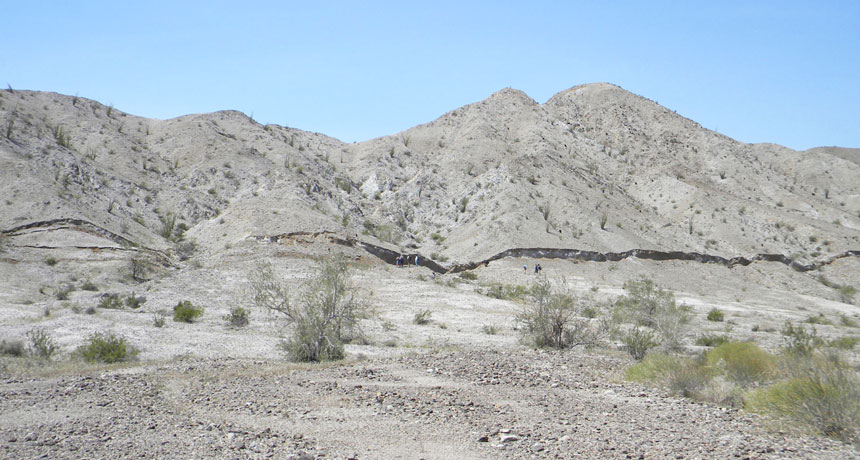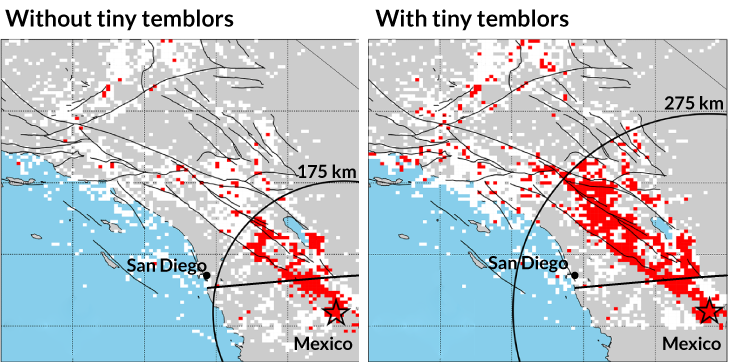A million tiny quakes shook Southern California — and no one knew
Data on lots of little quakes can help scientists learn about what triggers the big ones

This hillside cracked in 2010 during the magnitude 7.2 El Mayor-Cucapah earthquake that struck Baja California, Mexico. But more than a million tiny quakes also shook Southern California from 2008 to 2017, a new study found. Those included hundreds of previously unnoticed aftershocks from the 2010 quake.
Centro de Investigacion Cientifica y de Educacion Superior de Ensenada (CICESE)
Many people in California worry about the next “Big One.” They are referring to an earthquake strong enough to cause widespread damage. But tiny, undetected quakes rumble through Southern California all the time. There were millions of them in the last decade alone, a new study finds. Data on these “hidden” quakes could shake up what scientists know about how the tremors develop and interact.
Researchers at the California Institute of Technology in Pasadena mined an existing archive of earthquake data. Seismometers and other instruments had recorded the data from 2008 to 2017. The researchers used a technique called template matching. This allowed them to pick out quakes that previously had been too small to pick out from background noise. And their efforts paid off.
The results boosted the number of earthquakes in the Southern California Seismic Network archive to 1.8 million. That’s 10 times more than previously identified. The team reported the new number online April 18 in Science.

All those new data will help earthquake researchers ask questions they previously couldn’t, says Emily Brodsky. She’s a seismologist at the University of California, Santa Cruz, who wasn’t involved in the new study. Scientists can use statistics, for instance, to calculate whether an observed difference is likely due to chance. But “you can’t do statistics with small numbers,” Brodsky explains.
She likens the tiny quakes to fruit flies. Both are small and abundant. And that makes them useful for science. Large populations — whether of fruit flies or earthquakes — can help tease out what’s a real effect from what’s a fluke. Telling the difference is a chronic problem in earthquake studies, Brodsky notes.
Researchers have long suspected the tiny temblors existed. In 1944, scientists observed a strange relationship between earthquake magnitudes (strength) and frequencies (number). That is, for every unit increase in magnitude, there are one tenth as many quakes. So the vast majority will be small. So small, in fact, that many end up hidden among other sources of shaking picked up by seismometers.
“These instruments are incredibly sensitive,” notes Zachary Ross. An author of the study, he’s a seismologist at the California Institute of Technology in Pasadena. Seismic sensors record a broad range of vibrations. These include tremors due to construction, vehicle traffic, trains, air traffic — even noises from ocean waves crashing into a beach. All produce waves similar in size to those of very small seismic quakes, he notes.
Match making
Ross and his colleagues tried an idea first proposed 15 years ago. Template matching homes in on patterns to separate quake signals from all that noise.
Seismometers record quakes and other shakes as wiggly lines. The series of these coming from a quake on a particular fault creates a pattern. It can be as distinct as a fingerprint. That’s because the seismic waves are modified in a certain way by the rocks through which they pass underground. The resulting pattern of wiggles is called a waveform. Another quake on the same fault will show that same waveform — even if it’s bigger or much, much smaller.
The scientists first used data from a larger quake in a fault zone to identify the pattern for a fault. Then, in the small wiggles, “we look for something that has a near-identical waveform,” Ross says. That pattern matching helped his team find signals of the tiny quakes.
Previous studies had used this technique in a limited way. For instance, it had been used to map the tiny aftershocks related to a large quake. This new study is the first to use this technique on a larger scale. Here, it’s been applied to a whole database of regional seismic waves.
The project demanded intense computing power. And it took three years. But the rewards are worth it, Ross says. His team’s new catalog fills in gaps between larger quakes. Those links could tie together events that might previously have seemed unrelated.
“We’re starting to complete the story about the interactions between these events,” Ross says. That includes observing how earthquakes might cluster throughout a region and time. They also can start to identify the tiny foreshocks that might develop before a larger quake. From that, he says, scientists may be able to learn about the physics of how a given earthquake is born.
Brodsky also notes that these data could impact efforts to link human activities to earthquakes. For example, a magnitude 5.5 quake struck Pohang, South Korea, in 2017. In March, a government-commissioned panel calculated that the quake was triggered by water injected underground from a geothermal power plant.
“Arguments for whether or not something is human-induced revolve around timing and location,” she says. “The thing is, very often there’s a delay.” But if that apparent delay was filled with a series of tiny quakes? That could change how people determine cause-and-effect. And that could be a game-changer.







